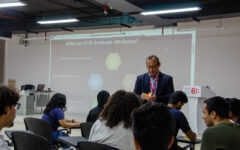Teaching and Learning Bulletin
16/10/2025 2025-10-16 15:55Teaching and Learning Bulletin
Reflection on Action: Making Reflection a Shared Professional Practice
During our Teaching and Learning seminar on Reflection on Action, colleagues explored what it means to pause, examine, and learn from our teaching experiences. Drawing on Donald Schön’s influential concept of reflection on action, we discussed how reflective practice can deepen our professional learning and shape our approach to teaching.
What is Reflection on Action?
Schön (1983) described reflection on action as the deliberate, critical examination of one’s practice after the event that is the process of looking back on what happened, analysing decisions made, and considering how they might inform future action. In a simplified framework, it’s about transforming experience into learning by asking: What happened? Why did it happen that way? What might I do differently next time?
This form of reflection moves beyond instinctive reaction. It invites us to unpack the assumptions, strategies, and values that underpin our practice, revealing what Schön termed our “theory-in-use” which are the implicit or unspoken principles that guide our teaching decisions. As Harrison (2012) notes, it is through a framework of reflection that teachers begin to build genuine professional knowledge and move from technical reflection (“what went wrong?”) toward critical reflection (“why do I teach this way, and to what end?”).
Why Does It Matter?
Teaching is dynamic, and our academic sessions are full of moments that deserve a second look. Reflection on action allows us to transform these moments into insights. It helps us frame and reframe our understanding of teaching challenges and reminds us that learning to teach is an ongoing, evolving process.
Critically, reflective practice also prevents teaching from becoming routine or mechanical. As Schön warned, when reflection-in-action (the decisions made in the moment) is not followed by reflection-on-action, professional knowledge can become stagnant. Instead, engaging in structured reflection which is improved when supported by dialogue with peers can create a space for growth and innovation.
During our seminar, colleagues where able to discuss the implications of the theory as well as teaching experiences, questioning not only what worked but why it worked, and how student responses might have been shaped by our choices.
How Can We Make It Work in Practice?
In higher education, reflective practice can take many forms from informal conversations after class to structured peer review or written reflection. What matters is that reflection is purposeful, evidence-informed, and dialogic rather than solitary.
At EUB, we are beginning to frame reflection on action through three complementary modes:
- Descriptive reflection – identifying what was done and why.
- Dialogic reflection – discussing alternative approaches with colleagues to consider new perspectives.
- Critical reflection – situating our actions within broader theories, ethics, and contexts.
These stages mirror Harrison’s (2012) conception of professional reflection as a movement from noticing and analysing towards transforming one’s understanding of practice. In our seminar, participants explored this progression by working through Schön’s What? So What? Now What? model a simple way of structuring reflection.
Reflection and Professional Learning
Reflection is most effective when it is shared. Schön himself cautioned against what he called “echo chambers of self-limiting reflection,” arguing that professional growth happens through dialogue and collaboration. This resonates strongly with the collegial culture we are building at EUB.
By engaging with each other’s experiences in seminar sessions, peer observations, or informal discussions we aim to improve our individual practice but also contribute to collective professional learning.
How the Teaching and Learning Centre Can Support You
The Teaching and Learning Centre at EUB supports staff in embedding reflective practice across their teaching. We offer structured opportunities to engage in reflection through our seminar series, peer learning groups, and individual consultations.
Our goal is to make reflection a sustained, shared process helping you to analyse your practice, identify areas for development, and experiment with new strategies. Schön’s notion of reflection on action reminds us that teaching develops through inquiry, experimentation, and continual adaptation.
References
Harrison, J. (2012) Professional Learning and the Reflective Practitioner. In Dymoke, S. (ed.) Reflective Practice and Professional Development in Education. Sage Publications.
Schön, D.A. (1983) The Reflective Practitioner: How Professionals Think in Action. Basic Books.







